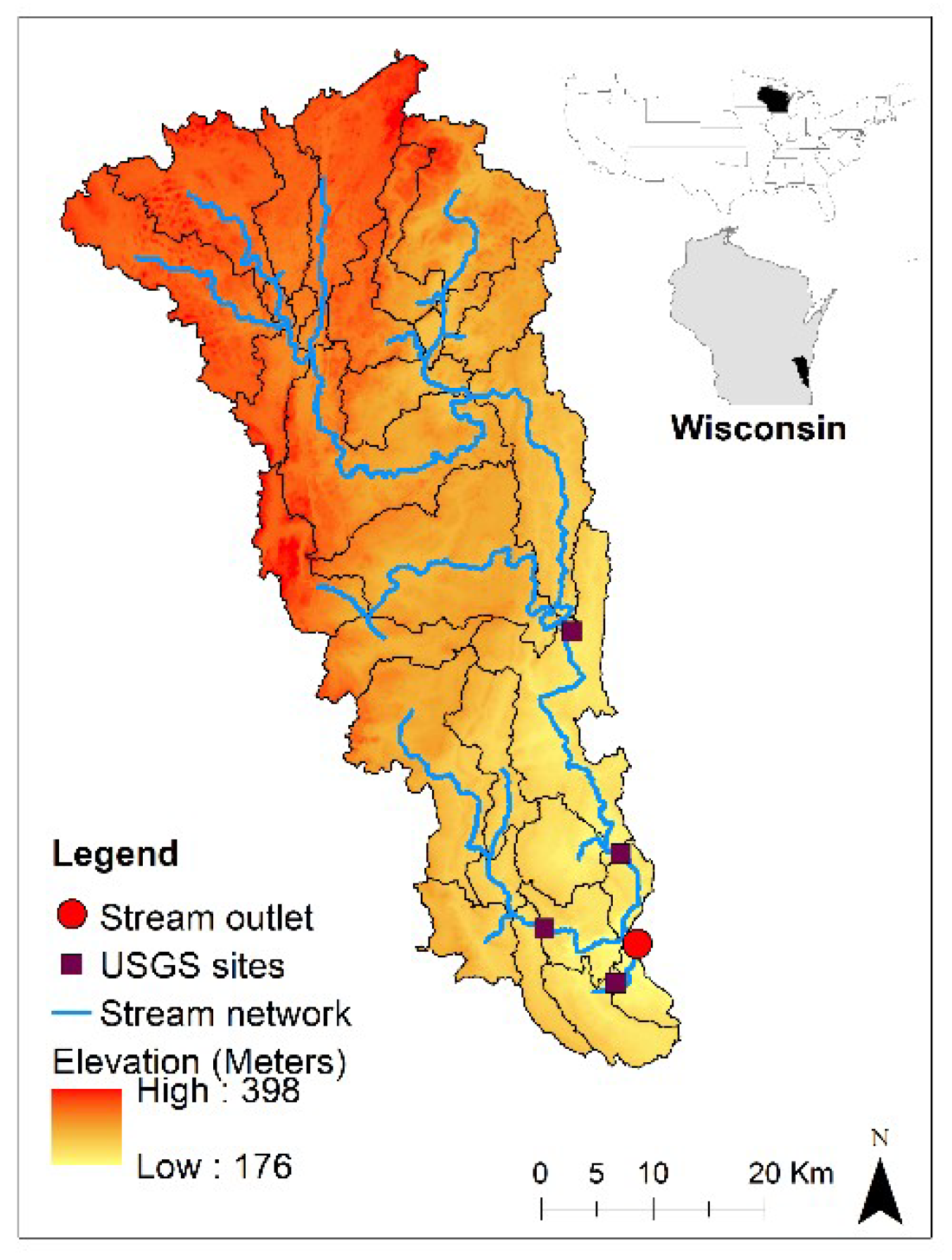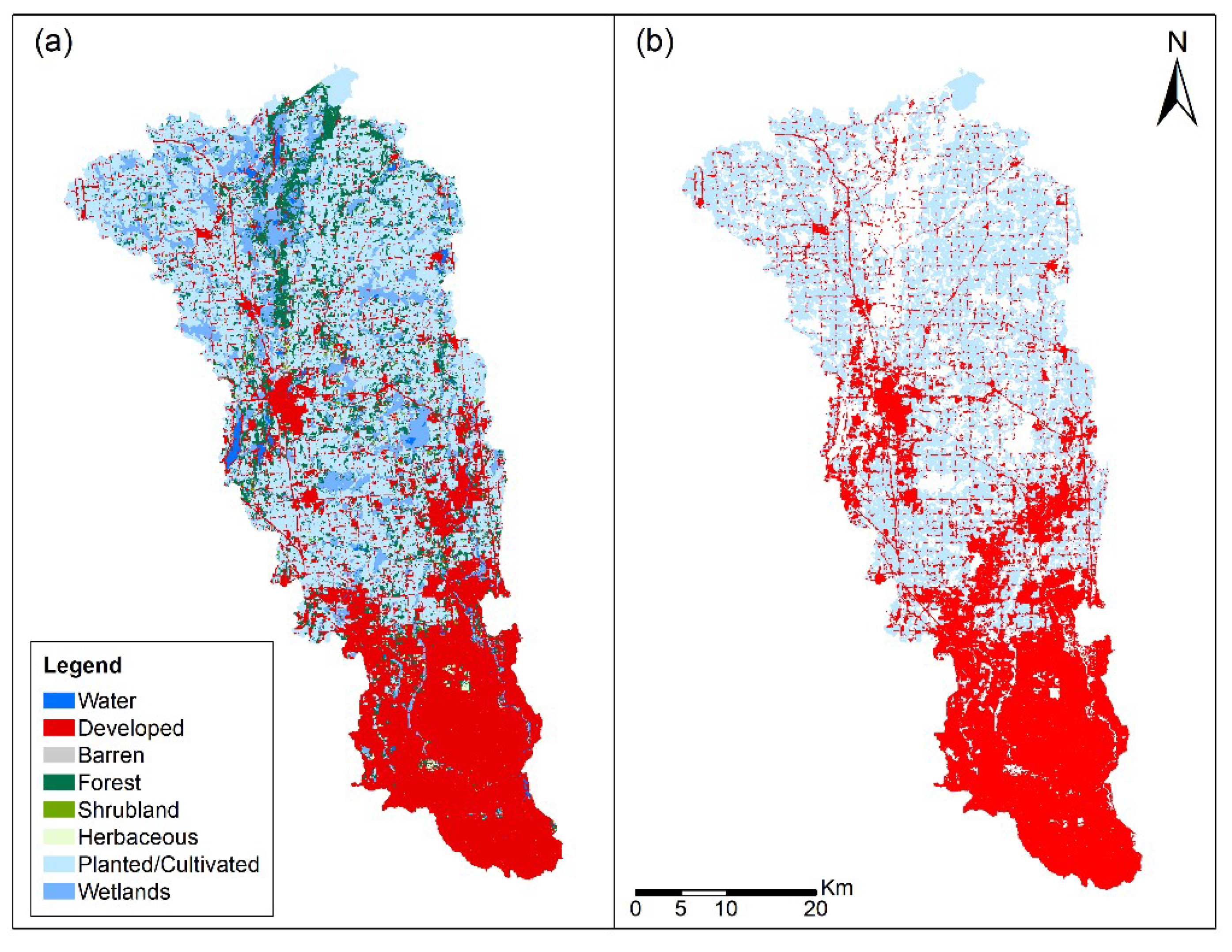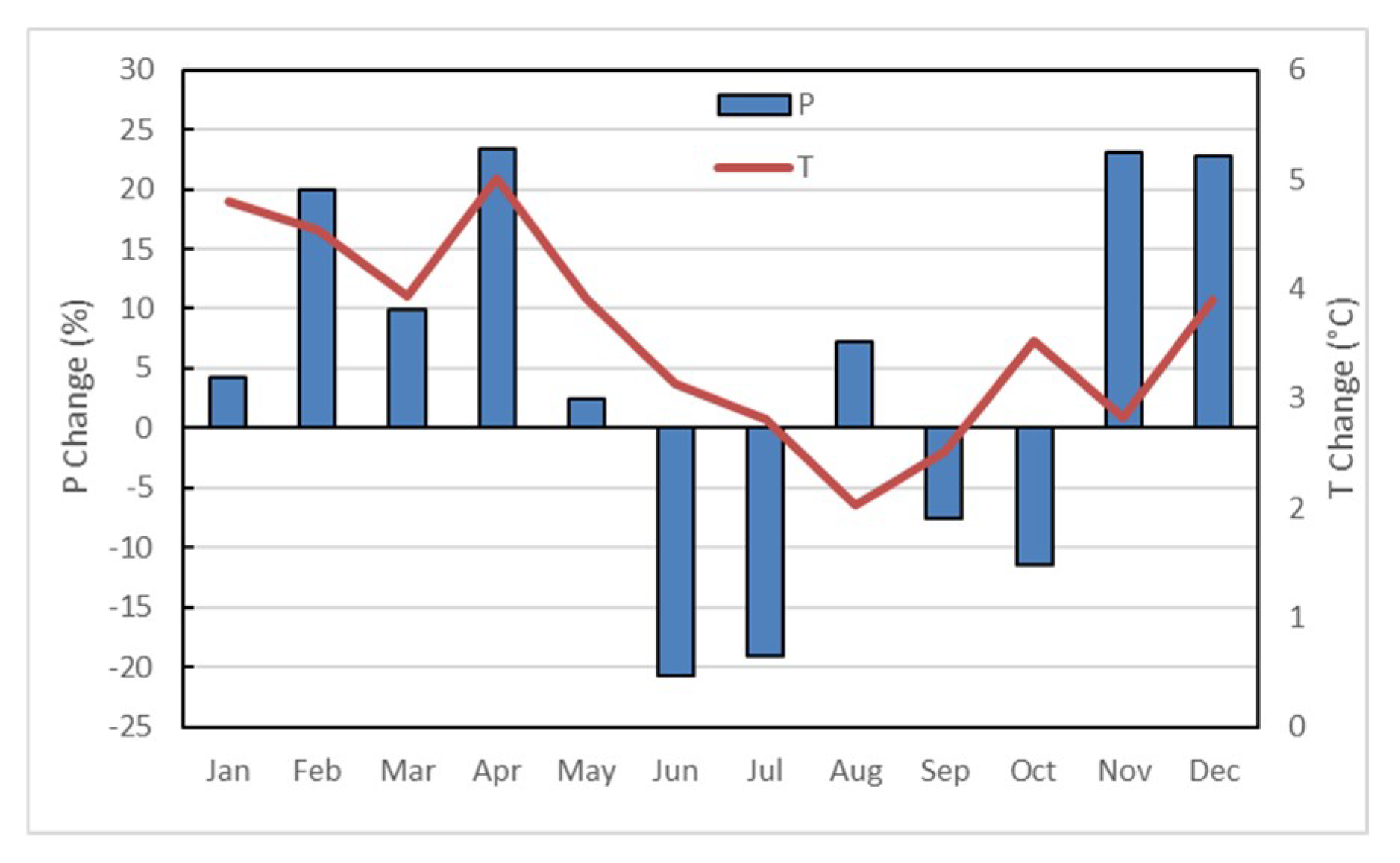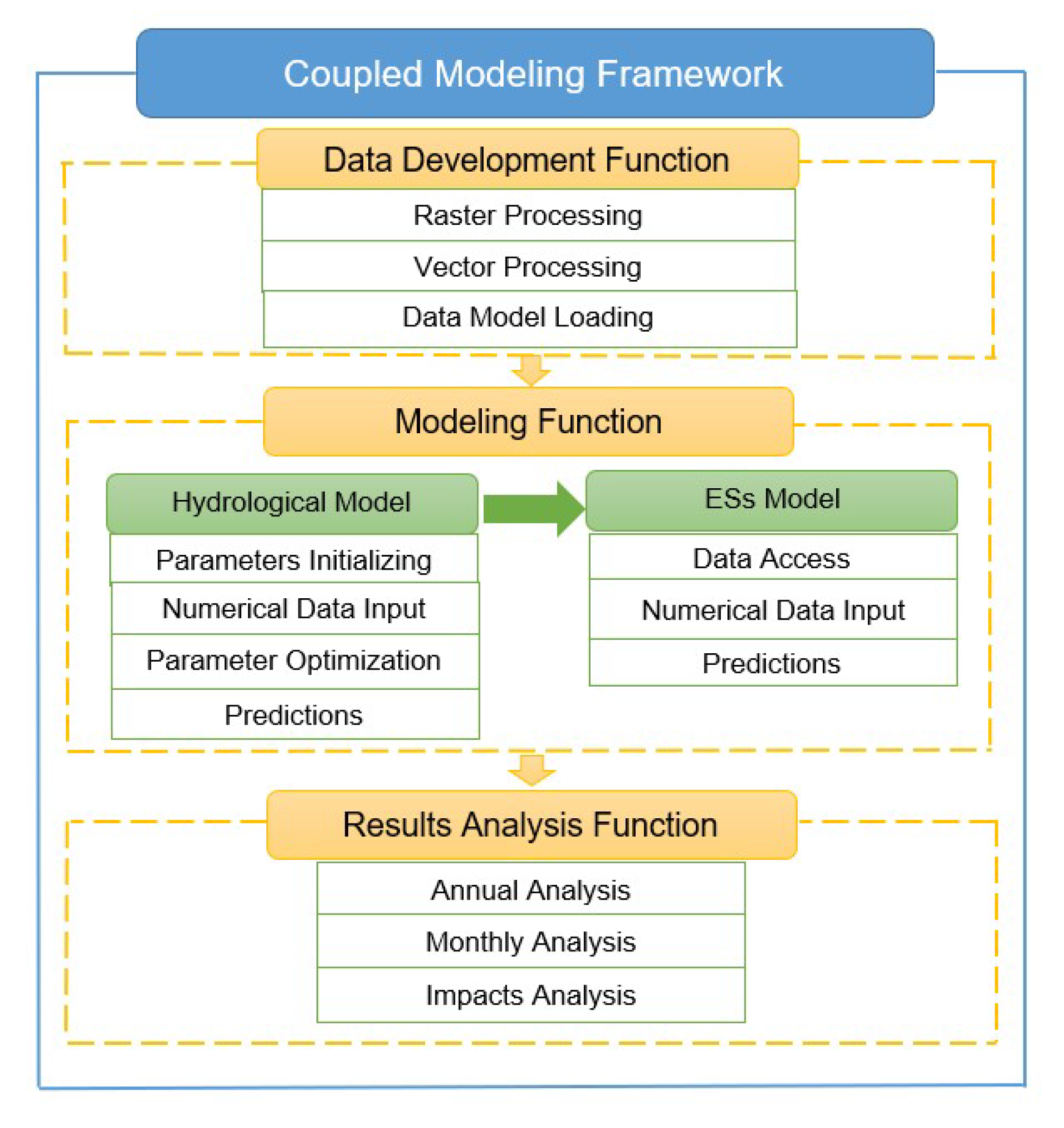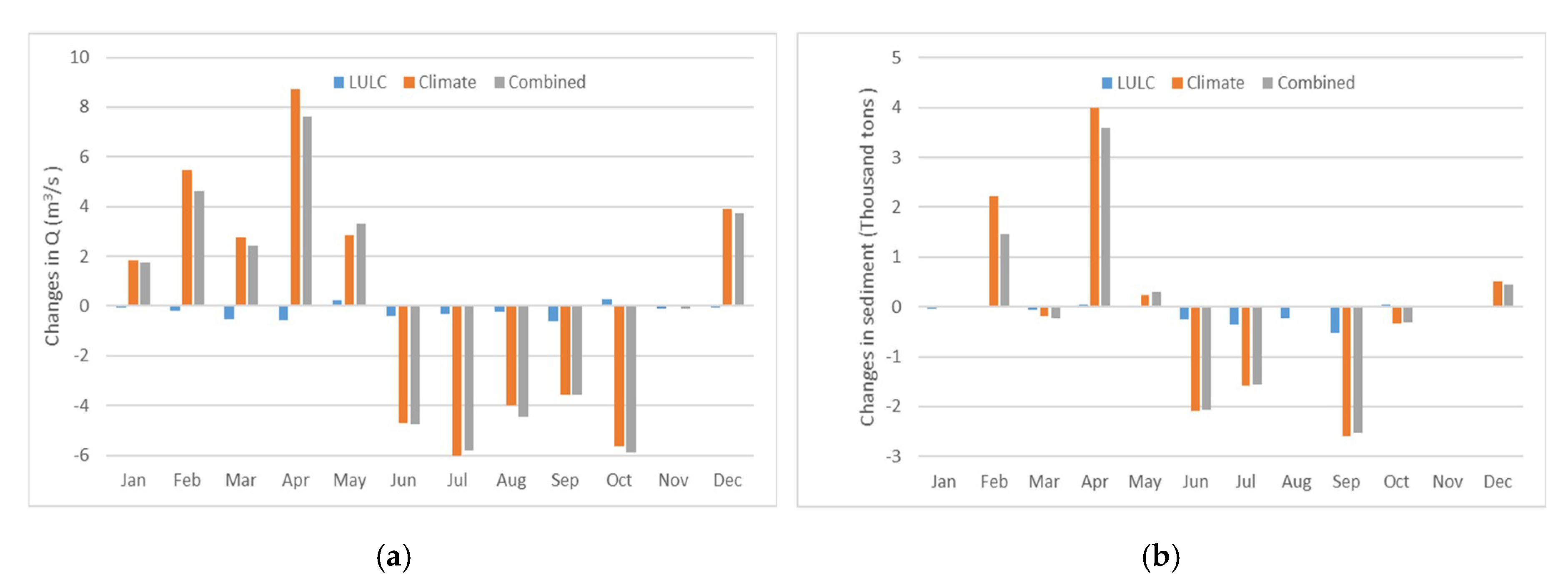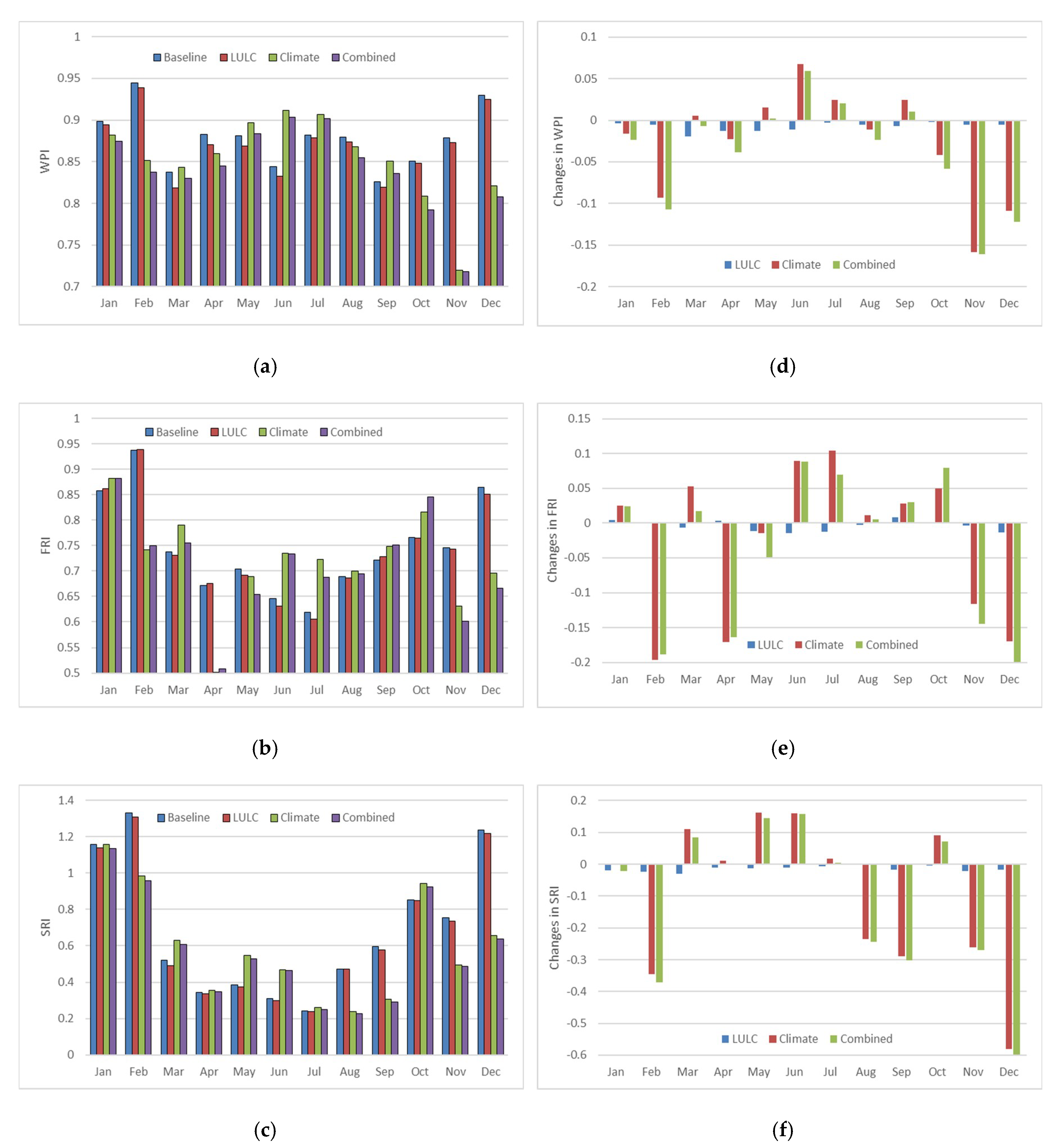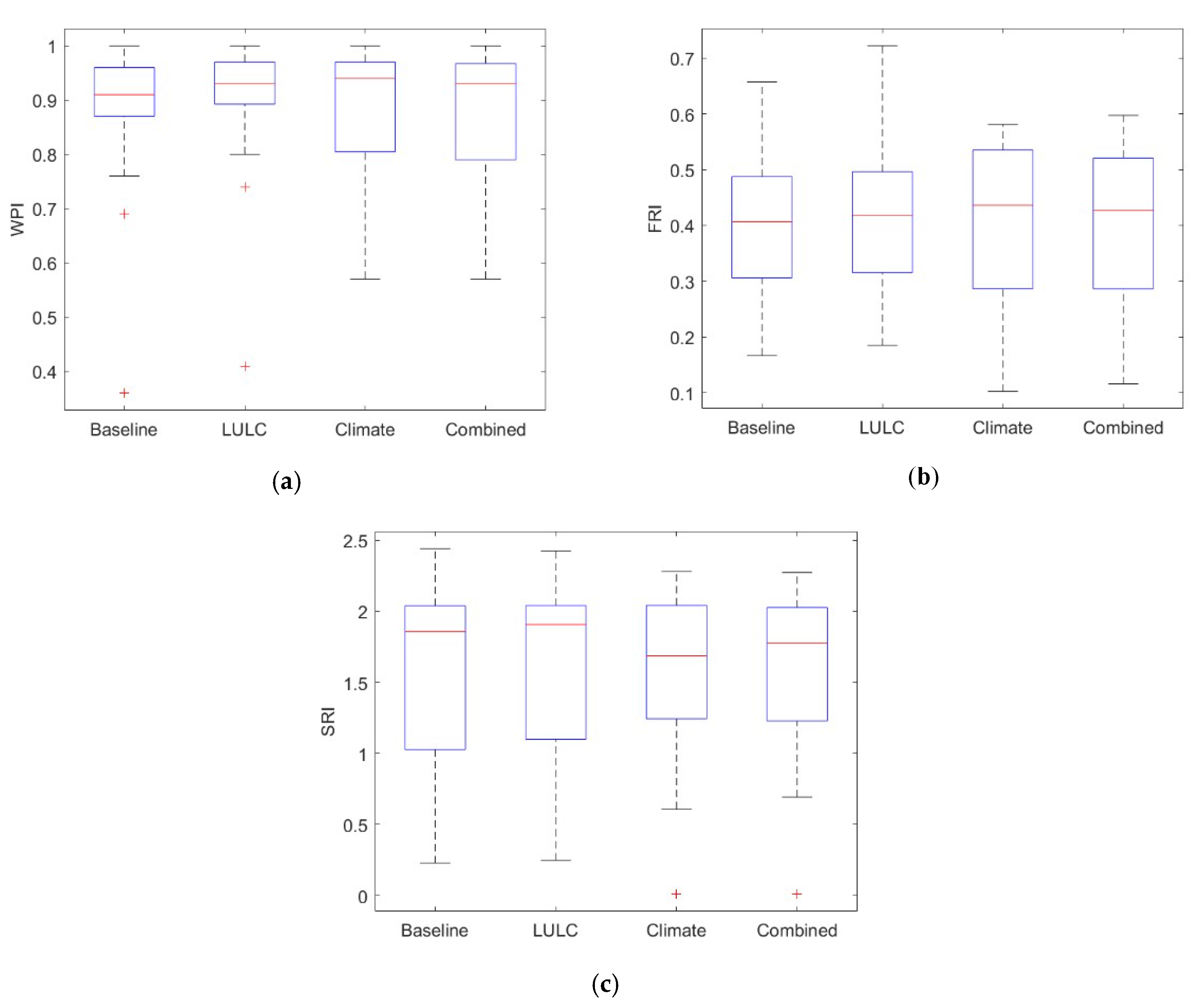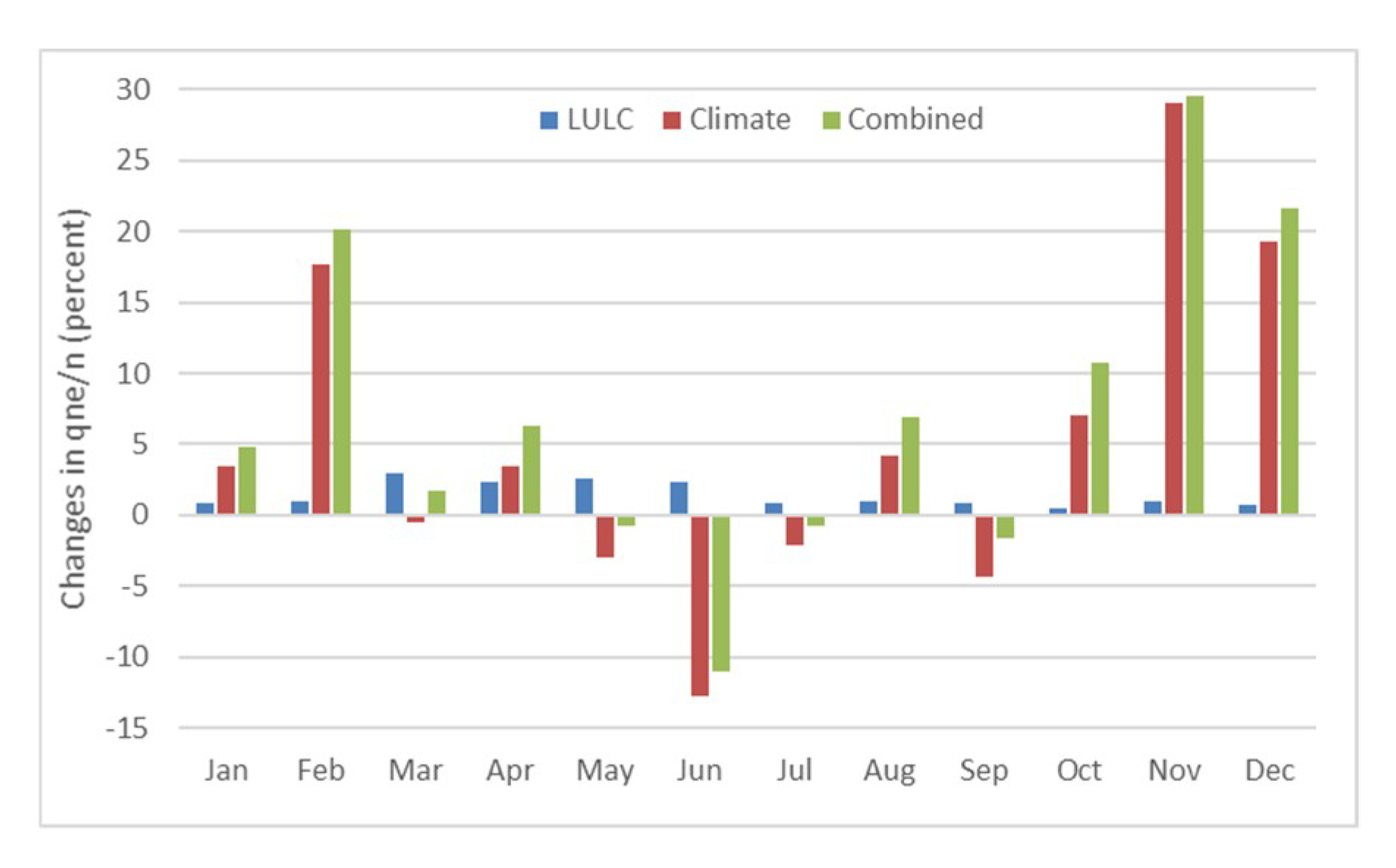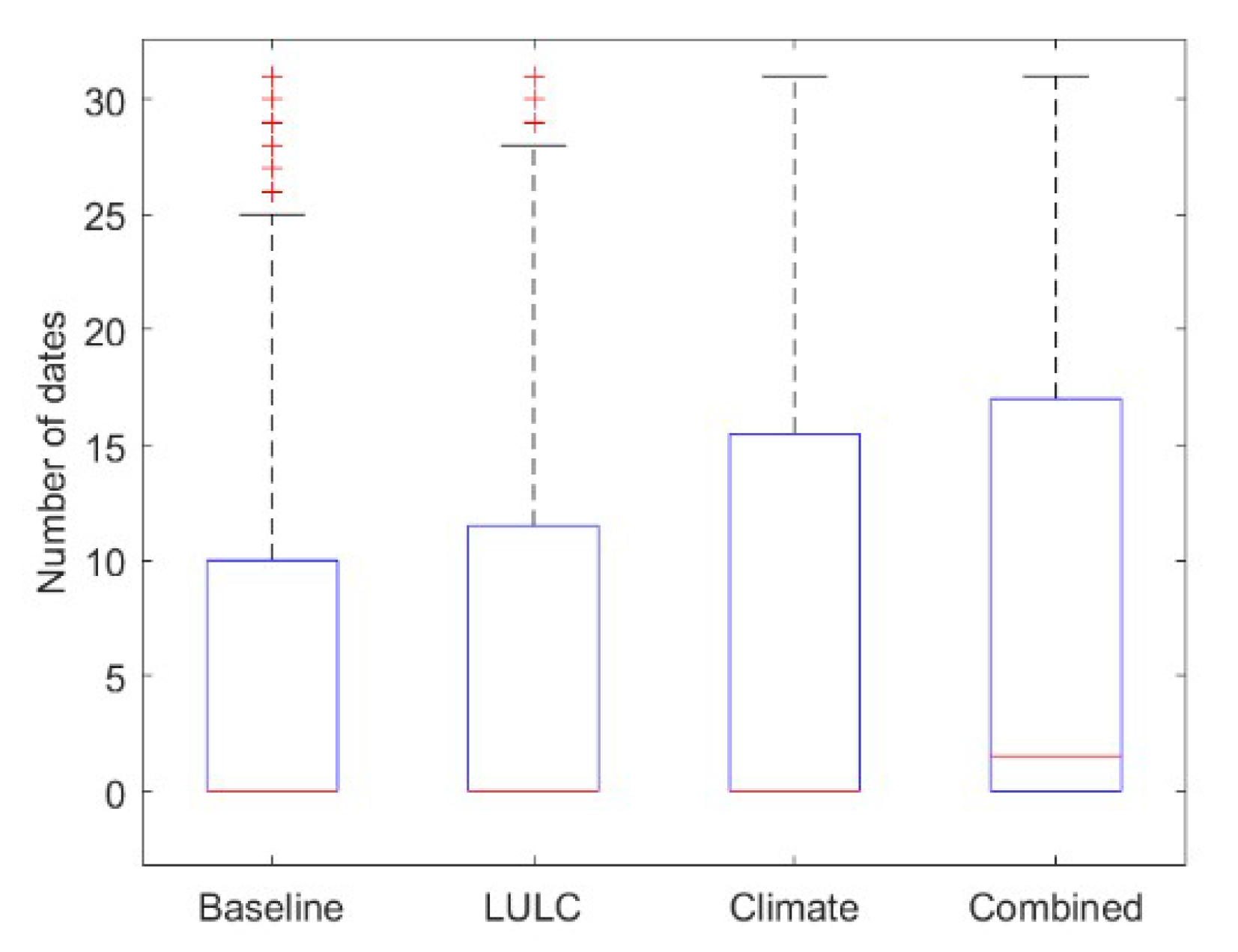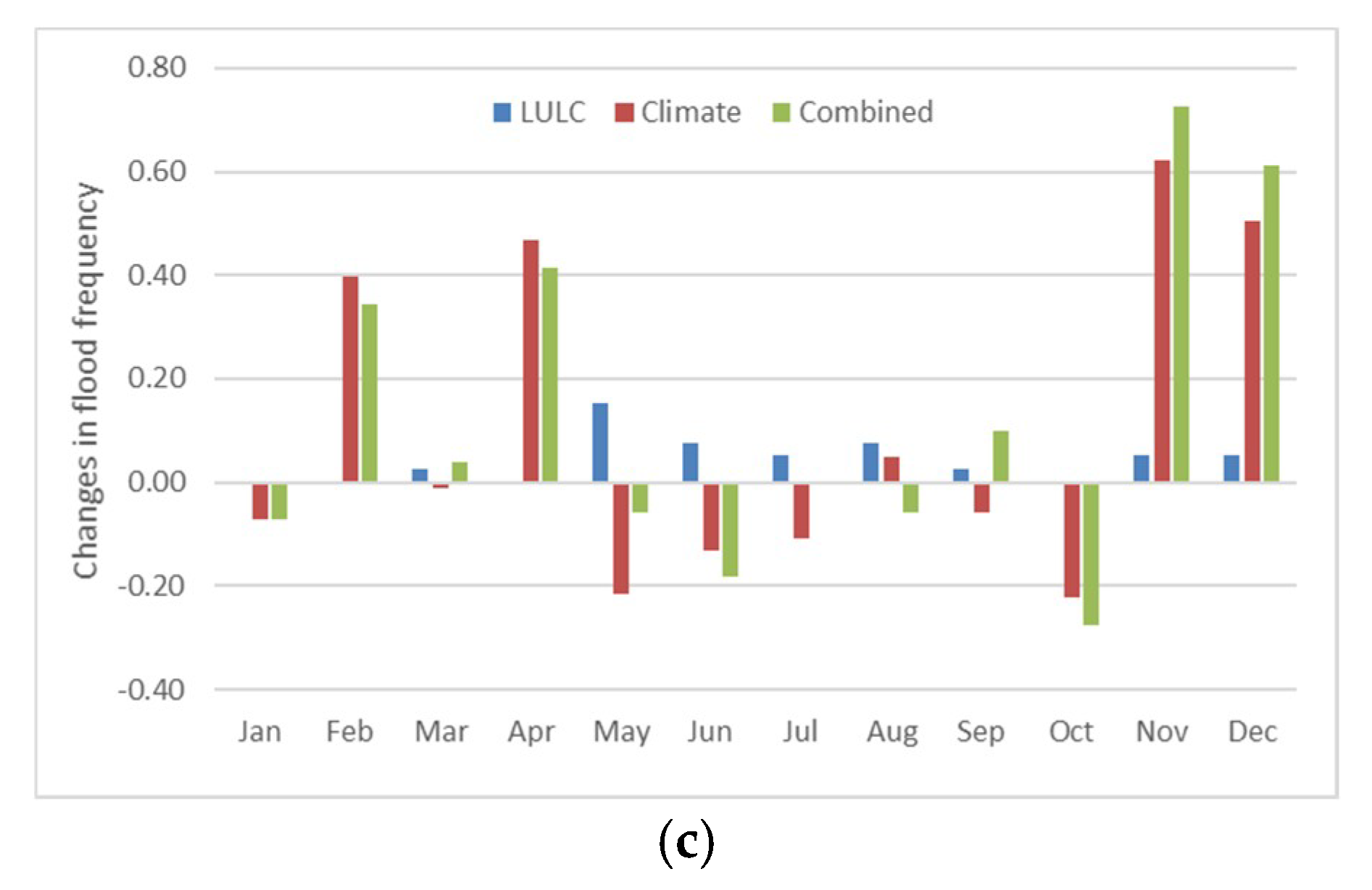1. Introduction
Ecosystem services (ES) are defined as benefits that human beings obtain from earth’s ecosystem functions [
1]. With their significance in terms of provision, regulation, supporting, and cultural services, conservation and improvement of ecosystems have been the crucial challenge to the sustainability of ecosystems, and research programs have been applied at different levels [
2,
3]. The evaluation methods of ES are still under development, although studies of ES have been conducted over the decades [
4]. Further development of ES models that are able to simulate ES with the integration of ecology, economics, and geography for use in planning and conservation is vital [
5]. Because hydrologic ES are affected by complex interactions of many environmental factors, robust understanding and skills for prediction and assessment are required [
6].
Land use/land cover (LULC) and climate changes are the two main factors affecting the spatial and temporal heterogeneity of ES [
7,
8,
9]. LULC changes have major impacts on ecosystems and the services they provide to people [
3], resulting in varying amounts and spatial distributions of ES [
10]. Urban expansion with an increased population is one of the dominant LULC changes that would influence the supply and demand of numerous ES [
11]. Another major factor that affects the distribution and functioning of ES is climate change [
12]. Based on the current climate projections, if mean annual water volume remains at the same level under climate change, the increased seasonal variations of water volume and frequency of extreme hydrological events (e.g., floods, droughts) will have substantial effects on hydrological ES [
13,
14,
15]. Climate change already affected species distribution, range, and interaction, and was projected to become a more significant threat in the coming decades [
16]. Climate change was expected to increasingly impact the provision and value of ES around the world [
17]. Impacts on natural ES, such as water scarcity, flood, and species habitat disappearance, would come about in unpredictable ways and levels [
18].
Although the effects of climate change on ecosystem functions have received significant recognition [
1], impacts of climate change on ES have not been well studied [
19]. When considering hydrologic ES, climate change that shifts the amount and timing of water movement through the landscape and alters the transport dynamics of nutrients and sediments need to be carefully considered [
7]. Numerous impact studies of LULC change on ES have been conducted [
20,
21,
22,
23], while studies of climate-change impacts on ES are limited [
24]. Furthermore, few studies have investigated hydrologic ES under impacts of both LULC and climate changes, and they have mostly focused on coastal protection services for flooding and erosion at a monthly scale [
25], and water supply, nutrient retention, and sediment retention at an annual scale [
7,
26]. But the evaluation of hydrologic ES, such as runoff, flooding, and erosion control under climate change at fine temporal scales has been rarely conducted. As mentioned in Pan and Choi [
27], hydrologic ES were temporally sensitive, and these fine temporal changes should be captured to reflect the complex hierarchical organization of ecosystem processes and heterogeneity across time. Thus, an approach or tool that can assess the impacts of LULC and climate changes on hydrologic ES at fine temporal scales is greatly needed for informing stakeholders and decision-makers.
Currently, hydrologic models and ES model are the most popular tools for hydrologic ES, but both are deficient when modeling LULC and climate-change impacts on hydrologic ES at fine temporal scales. Most hydrologic models do not include functions that convert hydrologic results to ES for decision-makers [
6]. On the other hand, modeling by ES models is limited and under development, since the temporal scale in ES modeling is still an issue that has not been fully considered [
6]. A comprehensive, temporally explicit framework that couples hydrologic and ES modeling would effectively accelerate the ES modeling processes. Studies have been conducted with a few different types of hydrologic and ES models for hydrologic ES [
28,
29,
30,
31,
32]. Cline et al. [
24] combined a hydrologic model with an ES model to evaluate the spatial and temporal patterns of fish density in the resident fish populations. Wlotzka et al. [
28] coupled hydrologic and ES models and assessed the C and N cycling for crop growth. Fan et al. [
29] used Soil and Water Assessment Tools and a conservation model to spatially analyze the relationships among different hydrologic ES under climate change. Nevertheless, these coupled modeling studies either did not focus on hydrologic ES or have fine temporal resolutions.
To overcome the weaknesses of previous impact studies of hydrologic ES as described above, a conceptual modeling framework [
27] was applied in the Milwaukee River Basin to simulate three hydrologic ES indices under LULC and climate changes in this study. The framework includes a data-development function, a modeling function with hydrologic and ES models, and a results-analysis function. This framework can capture the fine temporal changes in some hydrologic ES (e.g., water provision, floods) and thus benefit relevant management plans and policies accordingly.
Based on above-mentioned challenges, two research questions are addressed:
Detailed methods, results, and discussions are covered in the following sections. In
Section 2, the study area and scenarios design together with the framework are introduced. Results are presented in
Section 3 and the discussion of each hydrologic and ES variable in different scenarios is provided in
Section 4. Finally, conclusions are given in
Section 5.
4. Discussion
Based on Choi et al. [
34], the impacts of LULC change on hydrologic simulations are negligible, due to the moderate LULC change and the offsetting effects among different LULC classes. Since only one future LULC scenario was considered in this study and the future LULC map (CA 2050) developed for this study is close to realistic urban development without any assumption of management plans, the impacts of the LULC change on the hydrologic variables and ES are very limited. Moreover, the impacts caused by urban expansion (increased by 60 km
2) may also be offset by the reduction of planted/cultivated class, as shown in
Table 2 (decreases by 40 km
2). Such hydrologic simulation results lead to negligible hydrologic ES results. Gao et al. [
54] reported that hydrologic ES decreased by 3.8% in water yield and increased by 16.3% in soil exports under agricultural expansion scenario while increased by 4.2% in water yield and decreased by 16.3% in soil exports under soil conservation scenarios. Hoyer and Chang [
7] found out water yield is not sensitive to urban expansion scenarios as no difference found between results in different LULC-change scenarios while nutrient loading and sediment export are very sensitive to urban-expansion scenarios as changes ranged from –17% to 44% in sediment retention. Bai et al. [
55] also stated that agricultural expansion resulted in the lowest water yield and the highest one was generated by forestry expansion. According to Logsdon and Chaubey [
49], the extreme urban scenario had very limited impacts on hydrologic ES compared to the extreme agricultural scenario.
Climate change, unlike LULC change, has quite large impacts on hydrologic simulations [
31] and ES. Fan et al. [
29] found the climate scenario results in much more water yield than LULC scenario as future climate scenario created consistently increased water yield while LULC increased and then decreased water yield. Hoyer and Chang [
7] stated that water yield is very sensitive to different climate-change scenarios compared to LULC scenarios (climate change results –6% to 15% water yield while no changes find among LULC scenarios). Samal et al. [
30] demonstrated that climate change has a greater influence on future aquatic ES than changes in LULC. Results from this study also indicated that the climate-change impacts on hydrologic ES are much larger than the LULC-change impacts. The impacts under climate change at monthly scale show that streamflow, sediment, WPI, FRI, and SRI have the changes from −6 to 9 m
3/s, −2.5 to 4 thousand tons, −0.16 to 0.07, −0.19 to 0.1, and −0.58 to 0.15, compared to those under LULC-change impacts with the changes from −0.4 to 0.2 m
3/s, −0.5 to 0.001 thousand tons, −0.02 to −0.001, −0.025 to 0.01, and −0.03 to 0, respectively.
In term of climate-change impacts on streamflow, the annual precipitation increased about 6.6%, while the annual streamflow only increased 0.47% which is because even though the precipitation is the main source of streamflow, there are other factors influence the streamflow, such as soil moisture capacity, ground water level, and LULC classes etc. and therefore the streamflow did not increase or decrease with similar percentages as the precipitation. According to Choi et al. [
34], when the precipitation decreased or increased with large amounts in some other GCMs which surpassed the capacity of the landscape system, the increases or decreases in streamflow are substantial. Furthermore, compared to the limited changes in the climate scenario at annual scale (0.13 m
3/s, 0.14 thousand tons, −0.02, 0.01, and −0.01), the results at monthly scale show the large increased inter-monthly variation (4.73 m
3/s, 1.20 thousand tons, 0.07, 0.06, and 0.17) and the changes in each month (−6.02 to 8.70 m
3/s, −2.59 to 4.00 thousand tons, −0.16 to 0.07, −0.19 to 0.10, and −0.58 to 0.16) for streamflow, sediment, WPI, FRI, and SRI, respectively.
The WPI and streamflow showed a different changing pattern in monthly results. Since the most important input that affects streamflow volume is precipitation, with the projected increase in precipitation of 54 mm (
Table 3), the streamflow volume increased (
Table 5). However, as shown in
Table 6 and
Figure 6d, the WPI in the climate scenario decreased. In the calculation method of WPI, the qne/n (Equation (3)), which is the monthly percentage that the water provision is not met the long-term requirement, were calculated and plotted (
Figure 8). Compared
Figure 8 to
Figure 6d, it can be found out that the larger the monthly qne/n changes are, the larger the changes in the monthly WPI. Besides, as the results depicted in
Figure 9, the climate scenario results in larger variation than the LULC and baseline scenarios. Such evidence demonstrates that the climate scenario actually results in more days that were not met long-term water provision requirement although streamflow volume in general increased, which leads to a decrease in the WPI. This finding demonstrates that compared to streamflow volume, decision-makers should pay more attention to the increased low flow events that could severely impact water provision.
The FRI was found to be insensitive to any impact scenarios in annual results, however, it showed large changes in some months in the monthly analysis especially in the climate scenario. The three inputs of the FRI calculation (Equation (4)) were analyzed, and the results are presented in
Figure 10 and
Table 7. Based on
Figure 10, the duration, magnitude, and frequency of flood in the climate scenario all increased significantly at February, April, May, November, and December when the precipitation is high and decreased significantly at June and July when the temperature is high. Such results correspond to the increases and decreases of the FRI in the climate scenario in different months, which demonstrates that even though the impacts are negligible at an annual scale, it can still be identified at a finer scale (e.g., monthly scale).
Table 7 reveals that the LULC scenario reduced the duration and magnitude of the flood while the climate scenario increases all three of them. Flood frequency increased in all of the future scenarios compare to the baseline scenario. Findings from
Table 7 could inform decision-makers that LULC change could mitigate climate-change impacts and they need to pay attention to the increased frequency of flood events.
The climate scenario results in large changes in the monthly SRI compared to annual results that are negligible. Comparing the changes in monthly averages of streamflow (
Figure 5a) with that of the SRI (
Figure 6f), it can be observed that not all the monthly results of the SRI followed the pattern of streamflow changes in the climate scenario, especially in April, May, July, August, and September, that the SRI has the same changing direction as the streamflow (more streamflow results in more sediment and then low SRI). Such findings indicate that the highest sediment regulation demand did not come with the largest precipitation, but it also was associated with temporal soil erodibility variation [
56]. Such findings could remind decision-makers of the delay of sediment yield and soil erosion after the extreme events.
5. Conclusions
In this paper, with a conceptual modeling framework for hydrologic ES and the design of the scenario study, new insights were found regarding hydrologic ES under LULC and climate-change impacts in the urbanizing study area. Our study includes LULC and climate-change scenarios, and compares their impacts at both annual and monthly scales; and the latter are limited in hydrologic ES literature. The findings of this study could offer decision-makers and stakeholders more insights for land management plans.
The key findings of this study are that climate change has much larger impacts on hydrologic ES than LULC change, and also the results at the monthly scale show large increased inter-monthly variation and changes in each month compared to those at the annual scale. LULC-change impacts are small, due to the modest urban-expansion projection and the offsetting from the reduction of planted/cultivated LULC class. Streamflow, sediment, WPI, FRI, and SRI under climate-change impacts have the changes from −6 to 9 m3/s, −2.5 to 4 thousand tons, −0.16 to 0.07, −0.19 to 0.1, and −0.58 to 0.15, compared to those under LULC-change impacts with the changes from −0.4 to 0.2 m3/s, −0.5 to 0.001 thousand tons, −0.02 to −0.001, −0.025 to 0.01, and −0.03 to 0, respectively. In addition, compared to the limited changes of the results under climate change at annual scale (0.13 m3/s, 0.14 thousand tons, −0.02, 0.01, and −0.01), the results at monthly scale show the large increased inter-monthly variation (4.73 m3/s, 1.20 thousand tons, 0.07, 0.06, and 0.17) and changes in each month (−6.02 to 8.70 m3/s, −2.59 to 4.00 thousand tons, −0.16 to 0.07, −0.19 to 0.10, and −0.58 to 0.16). New insight was found that water provision does not correspond to streamflow volume, but is much sensitive to the low flow that does not meet the long-term requirement. Flood control is very sensitive to temporal scales with significant changes in monthly results but negligible changes in annual results, due to the sensitivity of the three input: Flood duration, flood magnitude and flood frequency. Sediment regulation results are more complicated, since they are not only affected by streamflow but seasonal erodibility, vegetation etc. In summary, climate change in this study has larger impacts on hydrologic ES than LULC change while LULC change could mitigate climate change with a reduction of plantation and cultivation. Such findings could provide decision-makers detailed and novel insights for management and conservation planning.
This study establishes a standard workflow for hydrologic ES modeling under LULC and climate-change impacts supported by national data products. Due to the timeframe limit and data availability, this study only utilized one LULC-change scenario and one climate model with one emission scenario. Such design has the limitation that the uncertainty from GCM projection cannot be eliminated, since comparison could not be made among the results of other GCMs, which could reduce the reliability of the results. Future studies could focus on adopting multiple LULC-change scenarios, other GCMs, and different emission scenarios for the analyses of tradeoffs and uncertainties. In addition, with more scenarios involved, the sensitivity of different temporal scales could also be further demonstrated. Finally, the modeling framework is still at the conceptual stage which includes all the necessary functions but not a user-friendly interface that could further assist stakeholders and the general public for understanding the processes and results. Such an interface could be built on a GIS platform, as a separate interface, or as a web-based interface depending on the workload and requirement from the stakeholders.
